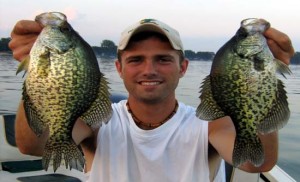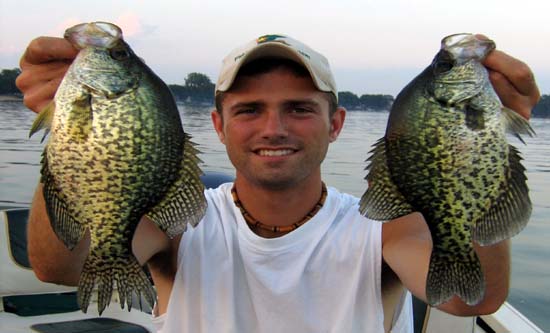 The springtime panfish flurry doesn’t last forever, and those same aggressive-natured fish will once again become less energetic and transform into wandering nomads, only feeding when their bellies tell them to. No longer do they devour whatever presents itself, or at least not in areas where we once sat wide-eyed at springtime and early summer. Now they are on a different path – a path that leads them into the dog days of summer… Here’s how to track those summer panfish patterns.
The springtime panfish flurry doesn’t last forever, and those same aggressive-natured fish will once again become less energetic and transform into wandering nomads, only feeding when their bellies tell them to. No longer do they devour whatever presents itself, or at least not in areas where we once sat wide-eyed at springtime and early summer. Now they are on a different path – a path that leads them into the dog days of summer… Here’s how to track those summer panfish patterns.
Many anglers stop pursuing panfish once the shallow water bite ceases, but it doesn’t have to be that way. Locating summer panfish shouldn’t be intimidating, and many times the fish are located in areas you seek out when bass or pike fishing. Weeds play an important role in summer panfish locations and the presence of deep weeds makes things just that much better.
Deep weeds and weed lines will draw in a huge smorgasbord of organisms for panfish to feed on, and in very high numbers. The cool water of the deep weeds is comforting to panfish and you can expect to find them there until the weeds change or the temps begin to drastically drop.
Classic summer panfish spots will remain true throughout much of the summer months and the panfish holding on them usually won’t go far if harsh weather presents itself. Deep weeds are a classic summer spot and should be a part of every panfish angler’s daily routine once the summer sun take form.
Weeds are very important, no doubt about that, and I usually seek out some form of weeds, whether it’s pockets or deep weed lines, but don’t let vegetation be your only guide to a day of success. Open water and mid-lake flats can prove equally victorious on some days too.
This pattern holds true for crappies more than sunfish, but every body of water is different and locations can vary.
Springtime panfish are universally sought-out, which is mostly due to their nature of being aggressively schooled-up and more than eager to attack whatever you put in front of their stout little noses. Big sunfish and slab crappies are caught throughout the Midwestern belt during the spring season and provide some excellent action.
Panfish will hold shallow, there is no use disputing a statement like that, but shallow is only relative to the body of water being fished. Shallow can mean 2 feet in the local farm pond, yet in the expansive reservoir across the street it can mean 8 feet of water off a break. Panfish typically hold shallow during the spring-fling as they begin their open water adventures.
The shallow water bite may last for a period of time, but those areas will change as the season progresses, and usually into conditions that make fishing them tough. Thick weeds begin to sprout up and fresh budding lily pads turn into thick mats of green and brown walls separating you from the underwater world.
Conditions call for a new approach and fishing patterns will tell you the same. It’s time to seek out a new area, because one, the old hot spot is unfishable, and two, the fish have found refuge in nearby deeper water, although weed pockets are an exception. Deeper water areas usually take the form of deep weed lines or out in open water of the main lake and mid-depth basins.
Around this time, most lakes experience an influx of thick, infectious weeds, which surround much of the shorelines and usually have a deep and shallow edge. Many lakes will see this veritable force beginning in 4-6 feet of water and ending where the water drops into deeper water, usually where the break line takes a drastic plunge. Some lakes will even have a deep edge along a flat or where the thick mat of weeds disperses into scarce weed patches as the bottom composition changes.
No matter the form it takes, these substantial weed lines will attract panfish, but effectively fishing them can be difficult unless you search out for pockets in the weeds. Weed pockets are often over-looked, but hopefully from now on you can begin seeing them as opportunities instead of just spaces of nothingness. These weed pockets all have the potential for producing panfish. Panfish are abundant underneath the vegetated barrier, and they are scurrying about picking off tiny morsels here and there.
You can bet a sunfish or crappies will snatch up an easy meal if it presents itself out in the open water of one of those pockets. Some days you can sit over one of these pockets and catch one fish after another. Several characteristics make weed pockets as effective as they are. Weed pockets provide an excess of sunlight, which will attract what attracts panfish – mainly baitfish and other forage.
Weed pockets also seem to have a different bottom composition in the immediate area, which will also attract surrounding organisms and water dwelling insects. Just like weed pockets grab our attention, they grab the fishes’ attention as well. Weed pockets are a part of my plan of attack when I hit the water in search of Dog Day Panfish.
Plastics tend to be my preferred way of targeting these weed-dwelling panfish. Various insect-type plastics offer a unique, natural-appealing presentation that works well in weedy conditions. Nymphs and other insects will utilize these particular areas, and it only makes sense that you “match the hatch”. I typically rig these plastics with either a plain hook (for neutral buoyancy) or with a light-wire jig head (for a more aggressive technique along deeper weed lines). Minnow baits are another excellent option.
Crappies will roam out in open water, and usually it’s the open water areas of a bay or the areas adjacent to deep weed lines and structure. Crappies like chasing down baitfish that are daring enough to adventure out into the open. The crappies know it’s an easy meal and that they have a huge advantage over their prey in situations like that. It’s not uncommon to find cruising pods of crappies out in 30 feet of water, suspended 10 feet off the bottom. This is where your electronics become your best friend as you search for these pods of fish.
Crappie locations during the hot summer months can be very frustrating on some lakes, and the possibilities seem endless. In order to narrow things down, you need to grab a lake map and look for possible springtime locations (where the crappies were just recently at) as well as nearby deeper water. Figure out where the deep weed line is and where, if any, is there deeper structure.
Crappies will hold near and around deep structure during the summer, then when the opportunity presents itself they will slide out into the open water to feed. You will even find lakes where the crappies hold out in the open water for extended periods of time, and they won’t feel the need to seek refuge around deep structure. Cruising the break line and deep open water adjacent from shallow structure—while watching your electronics—is a good way to locate a school of crappies. Once a school is located, it won’t take long to figure out whether or not they are hungry.
So, to expand on this concept of summer panfish, I will end with a question:
Why is it that during the winter months we target panfish in 30, 40 or even 50 feet of water, yet during the open water months we stop searching once we can’t find them in 5-6 feet of water?
The overlooked answer (that will help you this summer):
Panfish will utilize deep water just like walleye, bass and pike. Deep water shouldn’t scare panfish anglers, and having the willingness to target deep water during the summer months can really increase your catch. Some days it just takes patience and the motivation to look for meandering fish.
I’ve only touched on a few of the options that are available for panfish during the summer months, and don’t let these possibilities be your only resort. Fishing is constantly changing and we must change with it and adapt to the given conditions. Watch for pockets in the weeds, check for deep weed lines, and pay attention to your electronics for pods of schooling fish in deeper water while motoring from spot-to-spot.
By doing a few of these things you can eliminate some of the guesswork and wasted time spent on the water. But in the end, every day on the water is a good day if you have a fishing rod in your hand. Enjoy the summer and good luck!
Matt Johnson

